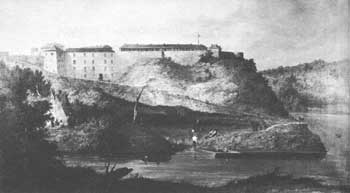





Survey of Historic Sites and Buildings
 |
FORT SNELLING Minnesota |
|
| ||
Ownership and Administration. Various.
Significance. This fort, constructed in the period 1819-23, was once the most northwesterly military post in the United States. Built to protect frontier settlers from Indians and to promote the fur trade, it became the northern outpost of a line of frontier forts—Leavenworth, Gibson, Towson, Smith, Atkinson, and Jesup—guarding the "permanent Indian frontier." Later, from 1861 to 1946, it also served as a training installation.
Just after the end of the War of 1812, the Army—seeking to extend U.S. control over the upper Mississippi Valley—planned a fort at the confluence of the Mississippi and Minnesota Rivers on land that Lt. Zebulon M. Pike had purchased in 1805 from the Sioux Indians. In 1819 Lt. Col. Henry Leavenworth led a detachment up the Mississippi from Prairie du Chien to build the projected fort and camped for the winter near an Indian village. The following year Col. Josiah Snelling assumed command and within 2 years essentially completed the fort. Originally called Fort St. Anthony, in 1825 it became known as Fort Snelling.
Fort Snelling guarded the vast region between the Great Lakes and the Missouri River. Few expeditions departed from the fort to attack the Indians, but officials cooperated with Indian Agent Lawrence Taliaferro in preventing clashes between the Sioux and Chippewas. Troops from the fort quelled the Winnebagos in the Prairie du Chien area, and policed the Canadian border to prevent French-Canadian hunters from crossing it to hunt buffalo. In 1849 troops from Fort Snelling joined dragoons from Fort Gaines to investigate Indian disturbances in Iowa, which later resulted in the founding of Fort Dodge.
After the frontier advanced to the Great Plains, Fort Snelling's importance declined, and in 1857 the Army abandoned it. Reactivated in 1861 as a training center for Civil War troops, it aided in quelling the Sioux uprising of 1862 and from then until 1946 served as a training center. At that time the Army abandoned the fort and transferred it to the Veterans Administration, which has released large portions of the military reservation to the State but still owns most of the original fort. Throughout the years other portions of the original reservation have come under private ownership. Fort Snelling is a Registered National Historic Landmark relating primarily to Indian-military affairs in the trans-Mississippi West.
 |
| Fort Snelling, Minnesota. Soon after the War of 1812, the U.S. Government erected a series of frontier forts just west of the Mississippi River. Fort Snelling, the northernmost, guarded a large area extending from the Great Lakes to the Missouri River. From a painting by Seth Eastman. Courtesy, Library of Congress. |
Present Appearance. Still standing are 4 of the original 16 structures; these consist of the quarters of the commanding officer, the officers quarters, a hexagonal tower, and a round tower. Excavations by the Minnesota Historical Society in 1957-58 uncovered the foundations of several structures, including the powder magazine, schoolhouse, sutler's store, hospital, shops, cistern, and a portion of the original walls. The fort is open to the public.
NHL Designation: 12/19/60
 |
 |
http://www.cr.nps.gov/history/online_books/founders-frontiersmen/sitec24.htm
Last Updated: 29-Aug-2005